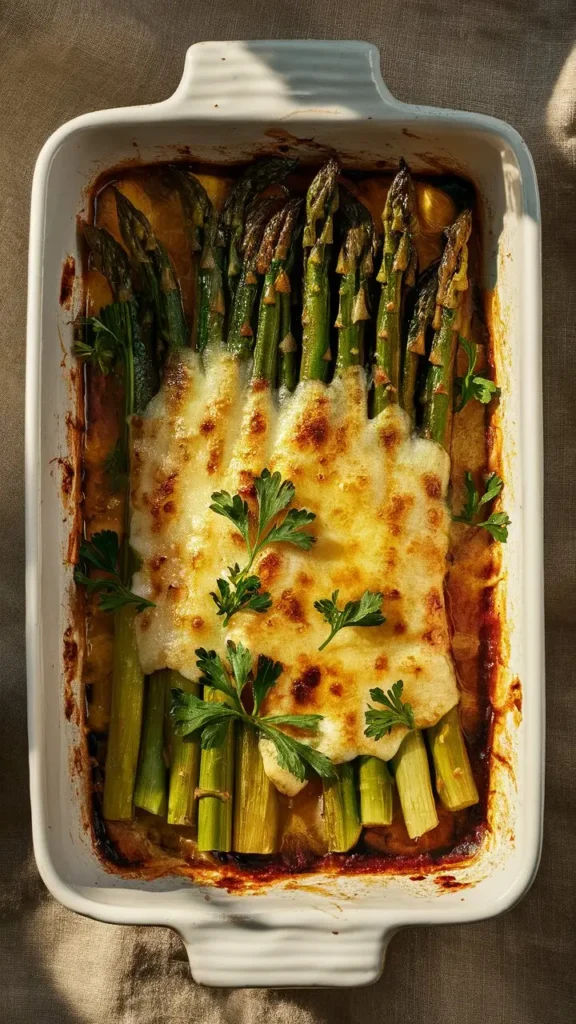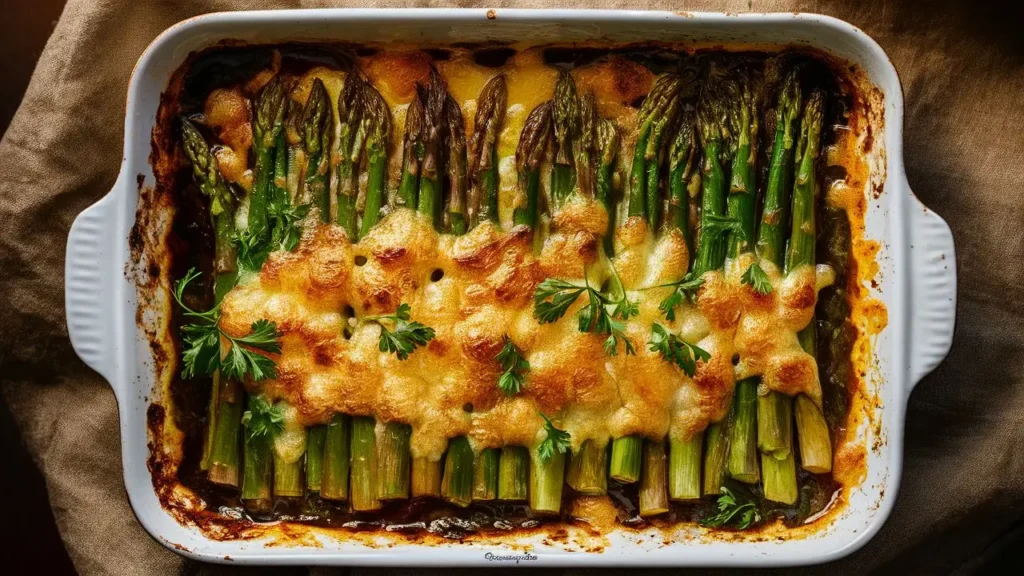Baked asparagus is one of those simple yet elegant side dishes that can elevate any meal. Whether you’re serving it with roasted meats, grilled fish, or a bowl of creamy pasta, baked asparagus brings a crisp-tender texture, savory flavor, and visual freshness to the plate. It’s quick to prepare, healthy, and incredibly versatile—perfect for everyday dinners or holiday spreads.
In this article, you’ll discover several variations of baked asparagus recipes, learn how to pick and prep fresh asparagus, and find tips to make your baked veggies taste even better every time.

Why You Will Love This Recipe
-
Quick and Easy – Minimal prep, fast cooking, and no complicated steps involved.
-
Nutritious – Asparagus is loaded with fiber, vitamins A, C, E, and K.
-
Versatile Flavors – Pairs well with garlic, lemon, parmesan, and even bacon.
-
Perfect Texture – Baking gives you a tender yet crisp bite without overcooking.
Ingredients List
Here’s a base list for a classic baked asparagus recipe. You can customize based on the variation you choose later.
-
1 bunch of fresh asparagus (about 1 lb)
-
2 tablespoons olive oil
-
2 garlic cloves, minced
-
1/2 teaspoon salt
-
1/4 teaspoon black pepper
-
1 tablespoon lemon juice (optional)
-
1/4 cup grated parmesan (optional)
Optional for variations:
-
Balsamic glaze
-
Red pepper flakes
-
Bread crumbs
-
Bacon bits
-
Shredded mozzarella
-
Dijon mustard
Timing & Servings
-
Prep Time: 10 minutes
-
Cook Time: 15–20 minutes
-
Total Time: 25–30 minutes
-
Servings: 4
Step-by-Step Instructions for Baked Asparagus Recipes
Step 1. Preheat the Oven
Set your oven to 400°F (200°C) to allow it to fully preheat while you prepare the asparagus.
Step 2. Wash and Trim the Asparagus
Rinse the asparagus under cool water. Snap off the woody ends—hold each spear near the base and bend until it naturally breaks.
Step 3. Season the Asparagus
Place the trimmed spears on a baking sheet. Drizzle with olive oil, then sprinkle with minced garlic, salt, and pepper. Toss to coat evenly and spread in a single layer.
Step 4. Bake Until Tender
Bake for 15–20 minutes, depending on the thickness of the spears. Thinner stalks take about 12–15 minutes, thicker ones may need 18–20.
Step 5. Add Finishing Touches
Remove from the oven and immediately sprinkle with parmesan or a squeeze of fresh lemon juice. Serve warm.

Variations to Try
Garlic Parmesan Baked Asparagus
Add grated parmesan before baking for a golden crust. Great for cheesy flavor lovers.
Lemon Herb Asparagus
Toss asparagus with lemon zest, thyme, and rosemary for a citrusy herb version.
Bacon-Wrapped Baked Asparagus
Wrap 2–3 stalks together in a strip of bacon and bake for 20–25 minutes until crispy. A hearty, savory option.
Balsamic Glazed Asparagus
Drizzle with balsamic glaze before serving for a tangy-sweet contrast.
Asparagus with Mozzarella and Tomato
Add halved cherry tomatoes and shredded mozzarella during the last 5 minutes of baking. This turns your side into a mini casserole.
Tips for Perfectly Baked Asparagus
Choose Fresh Asparagus
Look for firm, straight stalks with tightly closed tips. Avoid limp or shriveled ones.
Keep It Dry
Dry the asparagus completely before baking to ensure it roasts rather than steams.
Don’t Overcrowd the Pan
Spread in a single layer to allow heat to circulate evenly for crisp edges.
Adjust Seasoning
Customize with Italian seasoning, smoked paprika, or even a touch of cayenne for some heat.
How to Store Leftovers
Place any leftover baked asparagus in an airtight container and refrigerate for up to 3 days. To reheat, warm in a skillet or oven to retain crispness—avoid microwaving if possible.
How to Reheat Baked Asparagus
In the Oven:
Preheat to 350°F and reheat for 5–7 minutes until warm and slightly crisp.
On the Stovetop:
Heat in a skillet with a touch of olive oil over medium-high heat for 3–4 minutes.
Serving Suggestions
-
Main Dishes: Serve with grilled salmon, roasted chicken, or steak.
-
Brunch: Add to eggs benedict or a veggie omelet.
-
Pasta Side: Combine with creamy pasta like fettuccine alfredo or lemon spaghetti.
-
Holiday Meal: A fresh counterpoint to rich dishes on Easter, Thanksgiving, or Christmas.
Make It a Meal: Sheet Pan Dinner
Combine asparagus with other veggies like bell peppers and red onions. Add protein like chicken thighs or shrimp. Toss everything with oil and seasoning and roast together for a complete meal on one tray.
Nutritional Benefits of Asparagus
Asparagus is a low-calorie, fiber-rich veggie. It supports digestive health, may help lower blood pressure, and provides antioxidants and anti-inflammatory compounds.
Key nutrients include:
-
Vitamin K
-
Folate
-
Vitamin A
-
Potassium
-
Iron
Common Mistakes to Avoid
Using Too Much Oil
A light drizzle is enough. Excess oil can lead to soggy asparagus.
Overbaking
Watch closely in the last few minutes. Overbaked asparagus becomes mushy and dull in color.
Skipping the Toss
Always toss the asparagus in oil and seasoning evenly before baking.
FAQs
Can I use frozen asparagus for baking?
Fresh is best for baked recipes, but you can use frozen in a pinch. Thaw and pat dry thoroughly before baking.
How do I know when asparagus is done?
It should be tender when pierced with a fork but still have a slight bite. The tips may start to crisp slightly.
What if my asparagus is too thick?
Use a vegetable peeler to shave the lower ends or bake slightly longer, around 20 minutes.
Can I bake asparagus without oil?
Yes, but the texture may be drier. Use a nonstick baking mat or parchment paper to prevent sticking.
Is baked asparagus good for meal prep?
Yes! You can make a batch, refrigerate it, and reheat it throughout the week as a quick side.
Conclusion
Baked asparagus is one of the most effortless and flavorful ways to enjoy this vibrant green vegetable. Whether you stick with a classic olive oil and garlic version or experiment with bold toppings like parmesan, balsamic glaze, or bacon, there’s a variation to suit every taste. With its short cook time, adaptability, and nutritional profile, baked asparagus deserves a permanent spot in your recipe rotation.
